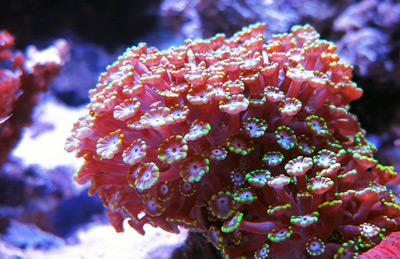“Caribbean Chris” and I are very frequently asked what it takes to convert a fish-only marine aquarium to a reef system containing corals and other sessile invertebrates. Can you just go ahead and add the invertebrates? Can you modify the existing system to suit the corals, or do you have to start the whole thing from scratch with a new tank and equipment? What has to change with respect to water conditions?
Hopefully, the following points/suggestions will help address these and various other questions marine aquarium hobbyists often have when contemplating the transition from fish-only (or fish-only-with-live-rock) to reef:
Pick a direction and do your homework
Before making any new purchases or modifications to your existing aquarium, it’s important to pin down the type of reef system you want to keep. Are you primarily interested in soft corals? Stony corals? Some combination of small-polyp scleractinians (SPS) and large-polyp scleractinians (LPS)? Will Tridacna clams be in the mix? Remember, the general direction and specific livestock you choose will influence how/whether you need to modify your existing system.
Then, just as you (hopefully) researched your fish community to ensure you could meet all the specimens’ care requirements and that they would be reasonably compatible with one another, you need to research the needs and characteristics of each invertebrate you’d like to keep. Yes, believe it or not, all kinds of compatibility issues can arise among corals! Don’t just start buying invertebrates that look pretty and shoehorning them into your tank. That’s a recipe for certain disaster.
Upgrade your lighting
In all likelihood, your fish-only system is illuminated with some form of normal-output lighting that will not be adequate for sustaining photosynthetic invertebrates. Remember, most (though not all) of the corals and other sessile invertebrates in the aquarium trade derive much of the nutrition they need from symbiotic algae, called zooxanthellae, residing in their tissues. To keep zooxanthellae alive and happily photosynthesizing, lighting of sufficient intensity and spectral characteristics must be provided.
Of course, to complicate matters, there are myriad reef-lighting options out there—e.g., metal halides; LEDs; T5, T8, and compact fluorescents; and various combinations thereof—and not all photosynthetic invertebrates share the same lighting requirements. So again, it’s very important to research the specific needs of the animals you plan to keep and the lighting options available to you.
Think of your reef lighting as the energy source that drives the whole system. This will be, far and away, your biggest expense in making this transition, but reef lighting is not an area where it’s wise to cut corners. Also, you can’t always accept at face value manufacturers’ claims that their lights are suitable for photosynthetic invertebrates. Work with a trusted dealer or other reliable expert to determine what type of lighting will be best for your planned system.
Evaluate your tank configuration
One reason you might want to consider starting from scratch with a new tank is if the design or configuration of your current tank isn’t conducive to keeping corals—for example, if it’s a tall, narrow tank rather than a short and wide one, or if it isn’t/can’t be drilled for overflow and return plumbing, etc. There are ways to get around the latter limitation, but if you have the wherewithal, it’s best to start out with the right tank.
Evaluate the reef-friendliness of your fish
Though all the specimens in your current fish community may be coexisting peacefully, some of them may prove problematic once sessile invertebrates are added to the mix. You may need to consider rehoming certain specimens if:
- Coral polyps are on their natural menu.
- They have a tendency to nip at fleshy corals and clam mantles.
- They’re messy eaters/copious waste producers, which can raise the level of dissolved pollutants beyond what’s acceptable to sensitive invertebrates.
- The overall stocking level—regardless of the specimens’ reef-friendliness—is just too high.
Evaluate your water movement
Appropriate water circulation is important in any marine aquarium, but it’s truly the lifeblood of a reef system. Corals depend on good water flow to carry off their waste products, prevent detritus from settling on their tissues, and deliver particulate foods/dissolved nutrients.
However, just as with lighting, not all corals demand the same intensity of water flow. As you’re researching the corals you plan to keep, be sure to ascertain the level of circulation that’s appropriate for each species.
Review past treatments
If your fish-only tank was ever treated for ich or other parasites using a copper-based medication, you’ll have to tear down the whole tank and start over again, with new rocks and substrate. Copper bonds with calcareous materials (e.g., live rock) and can then be released back into the tank, killing the invertebrates.
Adjust your specific gravity
Many marine aquarium hobbyists who keep fish-only tanks maintain the specific gravity of their systems at lower-than-natural levels, often somewhere in the range of 1.020 to 1.022. For a reef system, the specific gravity needs to be closer to that of natural seawater—1.024 to 1.025. This change is certainly easy enough to make, but it can’t be ignored.
Prepare to supplement calcium and alkalinity
Last but certainly not least—and I’m sure I’ve overlooked a few relevant points (which, hopefully, other salties out there will share in the comment section below)—hobbyists making the transition from fish-only to reef systems need to explore the various methods for supplementing calcium and alkalinity in their tanks.
In fish-only tanks, calcium and alkalinity are usually maintained at appropriate levels through water changes. However, in reef systems, these constituents may be used up by growing corals faster than they can be replenished via water changes alone—thus the need to supplement them using a method such as dripping kalkwasser, dosing two-part calcium/alkalinity additives, or employing a calcium reactor.



